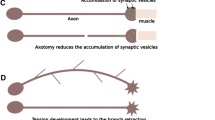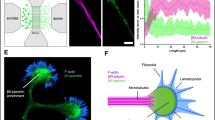Abstract
Intracellular tension is the most important characteristic of neuron polarization as well as the growth and regeneration of axons, which can be generated by motor proteins and conducted along the cytoskeleton. To better understand this process, we created Förster resonance energy transfer (FRET)-based tension probes that can be incorporated into microfilaments to provide a real-time measurement of forces in neuron cytoskeletons. We found that our probe could be used to assess the structural tension of neuron polarity. Nerve growth factor (NGF) upregulated structural forces, whereas the glial-scar inhibitors chondroitin sulfate proteoglycan (CSPG) and aggrecan weakened such forces. Notably, the tension across axons was distributed uniformly and remarkably stronger than that in the cell body in NGF-stimulated neurons. The mechanosensors talin/vinculin could antagonize the effect of glial-scar inhibitors via structural forces. However, E-cadherin was closely associated with glial-scar inhibitor-induced downregulation of structural forces. Talin/vinculin was involved in the negative regulation of E-cadherin transcription through the nuclear factor-kappa B pathway. Collectively, this study clarified the mechanism underlying intracellular tension in the growth and regeneration of axons which, conversely, can be regulated by talin and E-cadherin.







Similar content being viewed by others
Abbreviations
- FRET:
-
Förster resonance energy transfer
- NGF:
-
Nerve growth factor
- AJs:
-
Adherens junctions
- NF-κB:
-
Nuclear factor-kappa B
- AcpA:
-
Actin–cpstFRET–actin
- CSPG:
-
Chondroitin sulfate proteoglycan
- FAK:
-
Focal adhesion kinase
- ERK:
-
Extracellular regulated protein kinase
- ROCK:
-
Rho-associated coiled-coil containing protein kinase
- ZEB1:
-
Zinc finger E-box binding homeobox 1
- SIP1:
-
Smad-interacting protein1
- CFP:
-
Cyan fluorescent protein
- YFP:
-
Yellow fluorescent protein
- ATF:
-
Activating transcription factor
- HIF:
-
Hypoxia-inducible factor
References
Suter DM, Miller KE (2011) The emerging role of forces in axonal elongation. Prog Neurobiol 94:91–101
Friedland JC, Lee MH, Boettiger D (2009) Mechanically activated integrin switch controls alpha5beta1 function
Ayali A (2010) The function of mechanical tension in neuronal and network development. Integr Biol (Camb) 2:178–182
Ji L, Lim J, Danuser G (2008) Fluctuations of intracellular forces during cell protrusion. Nat Cell Biol 10:1393–1400
Critchley DR (2000) Focal adhesions—the cytoskeletal connection. Curr Opin Cell Biol 12(1):133–139
Balaban NQ, Schwarz US, Riveline D, Goichberg P, Tzur G, Sabanay I, Mahalu D, Safran S et al (2001) Force and focal adhesion assembly: a close relationship studied using elastic micropatterned substrates. Nat Cell Biol 3:466–472
Hirata H, Tatsumi H, Hayakawa K, Sokabe M (2015) Non-channel mechanosensors working at focal adhesion-stress fiber complex. Pflugers Arch 467:141–155
Yang C, Zhang X, Guo Y, Meng F, Sachs F, Guo J (2015) Mechanical dynamics in live cells and fluorescence-based force/tension sensors. Biochim Biophys Acta 1853:1889–1904
Zhang XH, Guo J (2015) Structural dynamics of live cells. Prog Biochem Biophys 42:540–542
Critchley DR, Holt MR, Barry ST, Priddle H, Hemmings L, Norman J (1999) Integrin-mediated cell adhesion: the cytoskeletal connection. Biochem Soc Symp 65:79–99
Brakebusch C, Fassler R (2003) The integrin-actin connection, an eternal love affair. EMBO J 22(10):2324–2333
Eva R, Fawcett J (2014) Integrin signalling and traffic during axon growth and regeneration. Curr Opin Neurobiol 27:179–185
Hirata H, Tatsumi H, Lim CT, Sokabe M (2014) Force-dependent vinculin binding to talin in live cells: a crucial step in anchoring the actin cytoskeleton to focal adhesions. Am J Physiol Cell Physiol 306:C607–C620
Hytonen VP, Vogel V (2008) How force might activate talin’s vinculin binding sites: SMD reveals a structural mechanism. PLoS Comput Biol 4, e24
Nuckolls GH, Turner CE, Burridge K (1990) Functional studies of the domains of talin. J Cell Biol 110:1635–1644
Izard T, Evans G, Borgon RA, Rush CL, Bricogne G, Bois PR (2004) Vinculin activation by talin through helical bundle conversion. Nature 427:171–175
Nhieu GT, Izard T (2007) Vinculin binding in its closed conformation by a helix addition mechanism. EMBO J 26:4588–4596
Tepass U, Godt D (2005) Talin’s second persona. Nat Cell Biol 7:443–444
Borghi N, Sorokina M, Shcherbakova OG, Weis WI, Pruitt BL, Nelson WJ, Dunn AR (2012) E-cadherin is under constitutive actomyosin-generated tension that is increased at cell-cell contacts upon externally applied stretch. Proc Natl Acad Sci U S A 109:12568–12573
Troyanovsky RB, Indra I, Chen CS, Hong S, Troyanovsky SM (2015) Cadherin controls nectin recruitment into adherens junctions by remodeling the actin cytoskeleton. J Cell Sci 128:140–149
Buda A, Pignatelli M (2011) E-cadherin and the cytoskeletal network in colorectal cancer development and metastasis. Cell Commun Adhes 18:133–143
Becam IE, Tanentzapf G, Lepesant JA, Brown NH, Huynh JR (2005) Integrin-independent repression of cadherin transcription by talin during axis formation in Drosophila. Nat Cell Biol 7:510–516
Zhang F, Saha S, Kashina A (2012) Arginylation-dependent regulation of a proteolytic product of talin is essential for cell-cell adhesion. J Cell Biol 197:819–836
Desiniotis A, Kyprianou N (2011) Significance of talin in cancer progression and metastasis. Int Rev Cell Mol Biol 289:117–147
Eberle KE, Sansing HA, Szaniszlo P, Resto VA, Berrier AL (2011) Carcinoma matrix controls resistance to cisplatin through talin regulation of NF-kB. PLoS ONE 6, e21496
Meng F, Suchyna TM, Sachs F (2008) A fluorescence energy transfer-based mechanical stress sensor for specific proteins in situ. FEBS J 275:3072–3087
Guo J, Wang Y, Sachs F, Meng F (2014) Actin stress in cell reprogramming. Proc Natl Acad Sci U S A 111:E5252–E5261
Meng F, Sachs F (2011) Visualizing dynamic cytoplasmic forces with a compliance-matched FRET sensor. J Cell Sci 124:261–269
Meng F, Suchyna TM, Lazakovitch E, Gronostajski RM, Sachs F (2011) Real time FRET based detection of mechanical stress in cytoskeletal and extracellular matrix proteins. Cell Mol Bioeng 4:148–159
Meng F, Sachs F (2012) Orientation-based FRET sensor for real-time imaging of cellular forces. J Cell Sci 125:743–750
Guo J, Sachs F, Meng F (2014) Fluorescence-based force/tension sensors: a novel tool to visualize mechanical forces in structural proteins in live cells. Antioxid Redox Signal 20:986–999
Aoki K, Nakamura T, Inoue T, Meyer T, Matsuda M (2007) An essential role for the SHIP2-dependent negative feedback loop in neuritogenesis of nerve growth factor-stimulated PC12 cells. J Cell Biol 177:817–827
Greene LA, Tischler AS (1976) Establishment of a noradrenergic clonal line of rat adrenal pheochromocytoma cells which respond to nerve growth factor. Proc Natl Acad Sci U S A 73:2424–2428
Lee SJ, Kalinski AL, Twiss JL (2014) Awakening the stalled axon—surprises in CSPG gradients. Exp Neurol 254:12–17
Zhou FQ, Walzer M, Wu YH, Zhou J, Dedhar S, Snider WD (2006) Neurotrophins support regenerative axon assembly over CSPGs by an ECM-integrin-independent mechanism. J Cell Sci 119:2787–2796
Sydor AM, Su AL, Wang FS, Xu A, Jay DG (1996) Talin and vinculin play distinct roles in filopodial motility in the neuronal growth cone. J Cell Biol 134:1197–1207
Minase T, Ishima T, Itoh K, Hashimoto K (2010) Potentiation of nerve growth factor-induced neurite outgrowth by the ROCK inhibitor Y-27632: a possible role of IP(3) receptors. Eur J Pharmacol 648:67–73
Monnier PP, Sierra A, Schwab JM, Henke-Fahle S, Mueller BK (2003) The Rho/ROCK pathway mediates neurite growth-inhibitory activity associated with the chondroitin sulfate proteoglycans of the CNS glial scar. Mol Cell Neurosci 22:319–330
Riento K, Ridley AJ (2003) Rocks: multifunctional kinases in cell behaviour. Nat Rev Mol Cell Biol 4(6):446–456
Hur EM, Yang IH, Kim DH, Byun J, Saijilafu XWL, Nicovich PR, Cheong R, Levchenko A et al (2011) Engineering neuronal growth cones to promote axon regeneration over inhibitory molecules. Proc Natl Acad Sci U S A 108:5057–5062
Tan CL, Kwok JC, Patani R, Ffrench-Constant C, Chandran S, Fawcett JW (2011) Integrin activation promotes axon growth on inhibitory chondroitin sulfate proteoglycans by enhancing integrin signaling. J Neurosci 31:6289–6295
McKeon RJ, Hoke A, Silver J (1995) Injury-induced proteoglycans inhibit the potential for laminin-mediated axon growth on astrocytic scars. Exp Neurol 136:32–43
Oohira A, Matsui F, Katoh-Semba R (1991) Inhibitory effects of brain chondroitin sulfate proteoglycans on neurite outgrowth from PC12D cells. J Neurosci 11:822–827
Ishizaki T, Uehata M, Tamechika I, Keel J, Nonomura K, Maekawa M, Narumiya S (2000) Pharmacological properties of Y-27632, a specific inhibitor of rho-associated kinases. Mol Pharmacol 57:976–983
Li H, Zhu YH, Chi C, Wu HW, Guo J (2014) Role of cytoskeleton in axonal regeneration after neurodegenerative diseases and CNS injury. Rev Neurosci 25:527–542
Schaefer AW, Schoonderwoert VT, Ji L, Mederios N, Danuser G, Forscher P (2008) Coordination of actin filament and microtubule dynamics during neurite outgrowth. Dev Cell 15:146–162
Prokop A, Beaven R, Qu Y, Sanchez-Soriano N (2013) Using fly genetics to dissect the cytoskeletal machinery of neurons during axonal growth and maintenance. J Cell Sci 126:2331–2341
Vaudry D, Stork PJ, Lazarovici P, Eiden LE (2002) Signaling pathways for PC12 cell differentiation: making the right connections. Science 296:1648–1649
Bakolitsa C, Cohen DM, Bankston LA, Bobkov AA, Cadwell GW, Jennings L, Critchley DR, Craig SW et al (2004) Structural basis for vinculin activation at sites of cell adhesion. Nature 430:583–586
Acknowledgments
This work was supported by grants from the National Natural Science Foundation of China (No. 81170714 and 81573409).
We apologize to all researchers whose relevant contributions were not cited due to space limitations.
Competing Interests
The authors declare that they have no competing interests.
Author information
Authors and Affiliations
Corresponding author
Additional information
Wang Dingyu, Meng Fanjie and Ding Zhengzheng contributed equally to this work.
Rights and permissions
About this article
Cite this article
Dingyu, W., Fanjie, M., Zhengzheng, D. et al. Regulation of Intracellular Structural Tension by Talin in the Axon Growth and Regeneration. Mol Neurobiol 53, 4582–4595 (2016). https://doi.org/10.1007/s12035-015-9394-9
Received:
Accepted:
Published:
Issue Date:
DOI: https://doi.org/10.1007/s12035-015-9394-9




